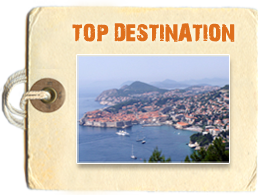
Aljmas, with the famous shrine of Our Lady of Sanctuary, or Our Lady of Aljmas, is situated on the tri-border area of Slavonia, Backa and Baranja, where the River Drava flows into the River Danube. The site was first mentioned in written documents in 1338. After Osijek had been liberated from the Ottomans in 1687, the locality was rehabilitated and the shrine established in 1704 as a subsidiary of the Osijek parish, administered by the Jesuit Order. Because of conflict with Calvinists, the Jesuits removed the statue of Our Lady to Aljmas, where believers there were only too ready to give it sanctuary, and so the statue became known as Our Lady of Sanctuary. In 1708 a new church, consecrated in 1715, was built and became the final destination for Osijek pilgrims. Both the church and the statue of Our Lady were destroyed by a fire in 1846, although a picture of the statue was preserved. In 1847 re-building of the church and the shrine, measuring 28 x 13 m, was begun. It existed until September 1991, when it was completely destroyed. Even so, the figure of Our Lady was preserved in the ruins and after its refuge in Osijek it was returned to Aljmas, where it has been a focus of pilgrimage since 1997. Pilgrimages attracting the greatest numbers occur on the occasions of Assumption Day and the Nativity of the Virgin Mary.
Biskupija near Knin
The shrine of Our Lady of Biskupija, or St. Mary of Croatia, is situated in the village of Biskupija, 5 km southeast of Knin, the former church and cultural centre of the Croatian state in the Middle Ages. Archaeologists have discovered the foundations of five churches in that village, dating from the period of Croatian rulers from the 9th to the 11th century. St Mary's church was the residence of the Bishop of Knin, who was Bishop of Croatia from 1040 to 1522. The earliest known figure of Our Lady in Croatian art was discovered by archaeologists in that same church on a part of the stone partition wall, which separated the shrine from the church nave. It is still venerated as Our Lady of the Great Croatian Vow. Today, on the foundations of the old Croatian church of the same name there stands a memorial church, decorated between 1937 and 1938 according to the designs of Croatia’s most famous sculptor, Ivan Mestrovic. The church is a single-nave building (16 x 8.4 m) with a square niche for the altar, and a 12.5 metre-tall steeple before it. Ivan Mestrovic also created the statue of Our Lady, depicting a Mother wearing a folk costume from Dalmatian Zagora, with a child on her lap, and who is writing the book of life. Regrettably, however, the statue was destroyed by Serbian extremists. Above the niche containing the main altar the renowned Croatian artist, Jozo Kljakovic, painted the fresco "King Zvonimir holding Court", which was also riddled by bullets fired by Serbian extremists. The church was thoroughly refurbished in 1966, when Mestrovic's statue was restored. Since then, the main pilgrimage occurs on the last Sunday in September, when the Holy Virgin’s name is honoured. The church was once again destroyed during the Croatian War of Independence, and now awaits rebuilding.
Karlovac
In Karlovac, founded in 1579 and which became an important cultural, commercial and industrial centre and whose parish was first mentioned in 1334, among its sacral buildings (including the early Baroque church of the Holy Trinity) the national shrine of St. Joseph on Dubovac is of particular interest. This modern church began to be built in 1968 and was consecrated in 1975. It was officially designated a national shrine in 1987. The main nave (33 x 17 m) is oriented towards the white marble shrine. The statues of St. Joseph and the Blessed Virgin Mary, cast in plaster, are the work of the academic sculptor, Ante Starcevic. Equally striking are the pictures of Croatian saints and blessed ones dating from 1985, as well as the picture of St. Joseph, the patron saint of the country, dating from 1988 - works by Prof. Danko Butala. The aisle of the shrine (17 x 17 m) is also dedicated to Croatian saints and blessed ones. The church has a steeple with three bells weighing 980, 520 and 297 kg. The most important pilgrimage occurs on 19th March, St. Joseph’s Day.
Ludbreg
Ludbreg, a small town in Podravina, 25 km southeast of Varazdin, mentioned in written documents for the first time in 1320, is particularly famous for the unique shrine of the Precious Blood of Jesus. The Ludbreg Parish of the Holy Trinity was listed by Deacon John in 1334, while the church itself was built in 1410. In 1411, a priest who was celebrating Holy Mass, after having uttered the words of transformation noticed true blood in the chalice. The Vatican was duly informed of the phenomenon and an investigation was carried out. On 14th March 1512, Pope Leo X issued a Bull proclaiming Ludbreg as the shrine of the Precious Blood of Jesus. The Blood of Jesus is housed in the parish church in a special reliquary. At its session in Varazdin in 1739, the Croatian Parliament decided to build the votive church of The Precious Blood of Jesus, to honour a vow made in an effort to prevent further deaths resulting from plague in Moslavina and Slavonia. However, its construction was not realised until 1994, when an extensive ‘stations of the cross’ was introduced, together with 14 chapels decorated with mosaics, which also serve as confessionals. The main pilgrimage takes place on the first Sunday in September.
Marija Bistrica
The greatest Marian shrine, officially proclaimed a national Marian shrine in 1971, is situated forty km northwest of Zagreb, in Marija Bistrica, first mentioned in written documents in 1209. Today, this shrine has a beautiful basilica - officially named by Pope Pius XI - and a votive altar which the Croatian Parliament commissioned in 1715. The spacious, unfinished "open-air church", the unfinished "wall of trust and hope" and Calvary - unique Stations of the Cross, are original artistic works by Croatian sculptors from the second half of the twentieth century. Veneration of Mary began in the fifteenth century when the black figure of Our Lady became famous for its miraculous powers. During the Ottoman invasion that figure was walled in on two occasions within the church walls. It was finally rediscovered in 1684 when, thanks to the efforts of the Zagreb Pauline Bishop, Martin Borkovic, the act of veneration strongly developed. The shrine has been constantly modernised and its ongoing, present-day improvement is a direct result of the visit made by Pope John Paul II on 3rd October 1998. The shrine in Marija Bistrica is the site of the greatest and the most important events in the church calendar, and is visited each year by between 500 and 800 thousand pilgrims. The shrine is open to pilgrims from early spring until late autumn.
Miraculous Statue
At the beginning of the 16th century an unknown local artisan carved a statue in black wood that was placed in a chapel on the nearby hill of Vinski vrh. In 1545, Turks attacked the area and the parish priest concealed the statue within the wall of a church in Bistrica. The priest died shortly afterwards and took the secret of the statue’s hiding place to the grave with him. After a miraculous vision in 1588 the statue was found and restored, only to be secreted once again, in 1650. Finally, the statue was restored on 15th July 1684 and on the very next day a series of miraculous healings and fulfilment of prayers began. Since that day, endless processions of pilgrims have visited Marija Bistrica.
Pilgrimages
Pilgrimages have been made to Marija Bistrica for 314 years. Every year up to 500,000 believers gather to participate in about fifty regular pilgrimages, which take place between Whit Sunday and Thanksgiving Sunday, at the end of October. The more important pilgrimages have traditional names: Whitsun, Votive of the City of Varazdin, Votive of the City of Zagreb, St. Margaret's, St. Anne's, the Transfiguration of Our Lord, Assumption Day, St. Bartholomew's, the Nativity of the Virgin Mary, and Thanksgiving. The hospitable people of Bistrica ensure that pilgrims are well looked after. Church festivals reflect the traditional customs of the Zagorje region. Masses of people, colourful stands offering hand-made souvenirs, delicious homemade food and drinks, and not least the beautiful surroundings, combine to guarantee an enjoyable stay in Marija Bistrica.
Sinj
The Sinj shrine is famous all around the world, wherever there are Croats. Numerous pilgrims come here to receive Holy Mary’s mercy and blessing.
Miraculous painting of the Madona of Sinj
In Sinj, the centre of the area of Cetina in the south of Croatia, is situated the shrine of Our Lady of Sinj, the greatest Marian site, and where a great fair is held. In 1715, about 700 people of Cetina, together with a number of Franciscan monks bearing a picture of the Mother of Grace, took refuge in Grad, the fortress above the present town, from an Ottoman army comprising ten thousand soldiers, who began a ferocious attack on 14 August. After three hours of furious assault, during which the Franciscans and the people prayed before the picture of the Mother of Grace, the all-conquering Turkish army suddenly and inexplicably took flight. The last Ottoman soldiers left the Cetina area on 15th August. Witnesses said that a white lady illuminated by a vast light had appeared before the besieging soldiers.
It is believed to this day that Our Lady achieved a great victory over the invading hordes. In honour of that great and miraculous triumph, a famous and unique knightly game, the Sinjska alka, (tilting at the ring) is held every year. The shrine of Our Lady of Sinj was renovated in 1721 and its present form dates from 1771, after it was restored following an earthquake. Four chapels were built on the lateral sides of church which are connected to the shrine via three doors, where believers make confession. Next to the shrine there is a 43.5 metre-high steeple, built between 1896 and 1927. In the shrine, next to which there is a Franciscan monastery housing a Classical Grammar school, there are many valuable works of art produced by Croatian visual artists. The most important pilgrimage occurs on Assumption Day, when many people arrive on foot, some even travelling barefoot. This is why in the town of Sinj, the feast day of the Great Lady Mary (Velika Gospa) on 15th August, is always particularly cherished and celebrated. So many cases have been reported of people receiving succour from the Madonna of Sinj (Sinjske Gospe), and many people suffering from various diseases have been miraculously healed. The people of Sinj and the Cetina district have presented a wreath comprising 12 silver stars to their patroness as a token of their gratitude and love.
Solin
In Solin, the greatest centre of Roman and old Christian antiquities in Croatia, veneration of Our Lady dates back to the 6th century and it is a known fact that in the 10th century St. Mary's church (23 x 10 m) existed there. It was built by the Croatian Queen Jelena (+ 975), wife of King Mihajlo Kresimir II (949-969) and mother of King Stjepan Drzislav (969-997). This church, a basilica with naves, aisles and square pylons, was not only the coronation basilica for Croatian kings but also a votive site where a fair was held. From 1537 to 1648, during Ottoman rule, the shrine fell into disuse and the church was pulled down. In 1670 a new church was erected on the foundations of the ruined one, but it was destroyed by fire in 1875. The present church was built above the ruined one in 1878, since when it has been known as the Croatian Lady Primordial Shrine. In 1898, the archaeologist Frane Bulic discovered the foundations of the Church of Our Lady, together with a nave and aisles and a partially destroyed inscription from Queen Jelena's sarcophagus, considered the most important inscribed stone document from the Croatia of the Middle Ages, since it was instrumental in defining the genealogy of Croatian rulers. Since 1976, when the millennium of that Croatian Marian primordial shrine was celebrated, the primordial figure in silver and gold of Our Lady of the Great Croatian Vow was placed inside the church. The shrine was visited by Pope John Paul II on 4 October, 1998. The most important pilgrimage of the year occurs on the Nativity of the Virgin Mary.
Trsat
In Rijeka, on Trsat, 135 m above sea level, from where there is a magnificent view of the Croatian Adriatic, of the islands and of Istria, with Ucka, there stands the ancient shrine of Our Mother of Grace, Our Lady of Trsat. The beginnings of that shrine are linked with the tradition which says that on 10 June 1291 angels brought from Nazareth to Trsat the house of Our Lady, but after 3 years and 7 months they transferred it to Loreto, where it has remained to this day. Hearing of the inconsolable grief of the Croats after having been deprived of the house from Nazareth, in 1367 Pope Urban V sent to Trsat an ancient picture of the Mother of God, venerated in Rome as having miraculous powers, and before which Croatian pilgrims began to assemble. The church of the Mother of God must have existed as early as 1419, and Prince Nikola Frankopan, the Croatian ban (Viceroy), started construction of a more spacious church and monastery, that was permanently inhabited by Franciscan monks in 1453. The shrine, reached via a flight of 561 steps, has been rebuilt and renewed several times, and in 1966 a particularly valuable chapel of votive gifts was built, followed in 1992 by a treasury and a gallery. The figure of Our Lady dates from the 14th century, and Mary’s life, presented in a series of 32 pictures, is a focus of attention in the monastery cloister. Seamen and other pilgrims arrive at the shrine at any time, but particularly on Marian feast days.
Vepric – Makarska
Croatian Our Lady of the Lourdes shrine was founded in 1908 by the bishop Dr. Juraj Carić. The natural cave and the entire landscape of small hills, vegetation and a stream is reminiscent of the Lourdes, where in 1858, the Blessed Virgin Mary revealed herself to Bernardici Soubirous 18 times.
Chapel with a sacristy, an altar, confession rooms, stations of the Cross, a retreat centre and procession paths were erected at the shrine. Due to its natural splendour and serenity, this shrine is well visited throughout the year and especially during the pilgrimage days: 11.02, 25.03, 15.08, and 8.09.
Vocin
The parish of Vocin, mentioned in documents for the first time in 1334, is situated on the north of Mount Papuk, its highest peak being 953m. The core of the shrine of God’s Mother of Vocin is situated within it, although only one part of the wall now exists after destruction caused by an explosion in 1991. The church was one of the largest in Slavonia (36 x 9 m) and originated from the period between the 12th and the 15th centuries. It was characterised by its unique architecture and was numbered among monuments of the highest category. From 1543 to 1687, Vocin was ruled by the Ottomans, after which the shrine was restored and administered by the Franciscan Order. The statue of Our Lady, purchased in Pécs, Hungary, was highly venerated but was destroyed, together with the church, during the Second World War. The shrine was restored to its original form and a new statue, Our Lady of Lourdes, was installed. Together with the church, which was turned into a storehouse for armaments, the statue was destroyed on 13th December 1991 during the Croatian War of Independence. In 1993, English, Irish, Scottish and Welsh believers presented the church with a new statue, and a temporary liturgical space was arranged. The greatest children’s pilgrimage is held in Vocin and other great pilgrimages also occur on Assumption Day and on the occasion of the Nativity of the Virgin Mary.





